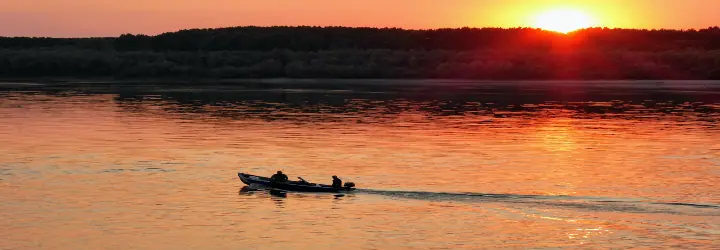9 Historical attractions you must visit on the Danube

The Danube is the heartline of eastern Europe, starting from the Black Sea cutting through many major countries before ending in Germany.
Such is the diversity of the cities along the Danube, it makes the river ideal for a cruising holiday. There is so much history attached to the waterway that is best experienced on a river cruise. There are a wide variety of Danube river cruises available such as starting in the Hungarian capital of Budapest, passing through the likes of Austria and Germany and ending in Amsterdam.
Along the way there is an abundance of historical sights which help to build the history of the Danube. Let's take a look at nine must-see attractions en route.
Shoes on the Danube Bank
Starting in Budapest, the Shoes on the Danube Bank is a highly poignant memorial. A collection of shoes on the banks of the river on the Pest side of the Danube Promenade honour the Jews who were killed by fascist Arrow Cross militiamen in the capital during World War II.
Created by film director Can Togay and sculptor Gyula Pauer, the memorial is a reminder of the tragedies which Budapest suffered during the war, while also commemorating the victims.
Schonbrunn Palace
This magnificent Baroque palace sits in the heart of Vienna, the next stop along the Danube. The 1,441-room palace is a former imperial summer residence originally purchased by Holy Roman Emperor Maximilian II in 1569.
It remains a focal point of Vienna's, and by a larger extent Austria's, style of architecture reflecting the changing taste of the Habsburg monarchs. Since the 1950s both the palace and the gardens have become major tourist attractions and were recognised as a UNESCO World Heritage Site in 1996.
Kunsthistorisches Museum
Staying in Vienna and another attraction to tick off is the Kunsthistorisches Museum. Translated as the Museum of Art History, this magnificent building has stood in the Austrian capital since opening in 1891. Commissioned by Emperor Franz Joseph I of Austria-Hungary it houses some of the nation's finest art.
Notable works currently installed at the picture gallery include Jan van Eyck: Portrait of Cardinal Niccolo Albergati (c. 1431), The Fight Between Carnival and Lent (1559) by Pieter Bruegel the Elder and Rembrandt: Self Portrait (1652). It is an absolute must for all art lovers.
Mauthausen Memorial
Not far from the Austrian city of Linz is the Mauthausen memorial. Mauthausen-Gusen was a concentration camp used by the Nazis during World War II. Between 122,766 and 320,000 people are estimated to have been killed here during Germany's occupation of Austria.
Liberated by the US Army in May 1945, Mauthausen is now a national memorial site. It remains largely intact covering almost 3,000 sq ft. There are a number of guided tours going on throughout the day.
Regensburg Dom
Moving into Germany and the Regensburg Dom should be high up on the itinerary for anyone cruising the Danube. This huge cathedral is a brilliant example of pure German Gothic architecture and forms the focal point of the city.
Founded in 1275 and completed in 1634, the Dom is home to some magnificent monuments including one by renowned German sculptor Peter Vischer the Elder. It is a sight to behold and a must-see when in Regensburg.
Nuremberg Palace of Justice
Nuremberg is a city of huge prominence in Germany. The second largest in Bavaria, behind Munich, it is a place of so much history none more so than the Palace of Justice. Justizpalast was built in 1916 and was the scene of the infamous Nuremberg Trials between 1945 and 1949 after World War II.
Courtroom 600 saw the trial of the main Nazi Germany personalities such as Hermann Göering, Rudolf Hess, Joachim von Ribbentrop and Arthur Seyss-Inquart. The courts are still used today and are open to the public.
Rhine Gorge
A magnificent natural sight in the heart of Germany, the Rhine Gorge is where the Rhine takes over from the Danube. The 65-kilometre section of river between Koblenz and Bingen was named a UNESCO World Heritage Site in 2002.
The area is unusual as it produces its own microclimate and has become the home to a number of species not generally native to this part of the world. Aside from this the gorge provides some splendid views.
German National Museum of Contemporary History
Moving on to Bonn in the North Rhine-Westphalia region of Germany and a must in this city is the German National Museum of Contemporary History. Charting the nation's past after 1945, the museum ranges from artefacts from over the previous decades to the changing face of politics in the country.
Admission is free and guide booklets can be obtained in English, as the exhibitions and tours are presented in German.
Anne Frank Huis
Ending the trip in Amsterdam, a visit to the home of Anne Frank is an absolute must. Situated at the Prinsengracht in central Amsterdam, this unassuming house was where Jewish wartime diarist Anne Frank hid from Nazi persecution.
The 17th-century canal house became a museum in May 1960, following the publication of Anne's diaries in 1957, she did not survive the war. Behind the Rijksmuseum and the Van Gogh Museum, Anne Frank Huis is well worth a visit.
Browse and book our Rhine river cruises